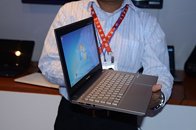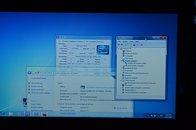Wednesday, January 11th 2012

Intel's Dodgy Ivy Bridge DX11 Demo: That Ultrabook Tested
Yesterday, we reported on Intel's embarrassing gaffe at demonstrating racing game F1 1 2011 running on a prototype ultrabook with an Ivy Bridge processor, where it was really just a video. Since then, AnandTech has seen that game play on an Ivy Bridge notebook just fine, but the best proof has come now, where they got hold of the actual ultrabook at the centre of the controversy and tested it with that game. The result? It works just fine, like we suspected. It looks like Intel just need a little PR makeover, is all. Video proof follows.


26 Comments on Intel's Dodgy Ivy Bridge DX11 Demo: That Ultrabook Tested
Regardless, it's doing very well to be playing it as well as it does.
Looking to be a low to medium performer, but no match for Trinity if that is the best it can do. Suspect it may get close to Brazos performance which is a good thing. Shows Intel is taking the APU threat seriously.
For 95% of the target market for this ultrabook, this is great performance.
Edit: I went back and watched the video again, and the video converter clearly has a "CPU" meter at the bottom monitoring CPU usage of the program. So we know at least the media converter was setup to use the CPU only and I'm guessing the HD Video playback is the same. So big deal, they are using a Quad-core for multitasking. Something that we already know IvyBridge does better.
Edit2: Also the game they are using is Dirt2. So not even close to a modern DX11 game at this point, and certainly not a "High End" one like they claim. In fact it is still using the Ego 1.0 engine, which barely has DX11 features at all(I think the crowds were tessellated and that is about it). They couldn't even managed to get Dirt3 running, which at least would use a modern DX11 engine, and the same engine as F1 2011 that Intel demos.
www.youtube.com/watch?v=agJxehoSBmY
- the AMD Trinity was running the medicoder program to use the CPU only, without GPU acceleration, that can be seen in the video.
- it was trans-coding various HD video files of unknown specs to iPad format, 1024x768, and again unknown quality.
- as for the video it was also playing on the laptop screen, again that is HD video unknown spec and quality.
The best part ?All that, running competently, and in 17WATTS is very impressive. hothardware.com/News/AMD-Fusion-APU-and-Graphics-Update-Trinity-7000M-Mobile-GPUs-and-Lightning-Bolt-In-Action/ <--- second paragraph mentions wattage.
looks like for 17watts you can get a mobile dual-core IvyBridge, but if you want a quadcore, that will cost you 45watts. this doesn't account for the performance compared to AMD's Trinity (cores perform differently per company), but it is interesting that AMD managed to get 4 Piledriver cores and a 7000-series GPU into 17watts.
www.cpu-world.com/news_2011/2011120601_Ivy_Bridge_mobile_CPU_lineup_revealed.html
It was using a barely DX11 capable game, using settings unknown(my guess medium or lower), while transcoding and playing and HD video using the CPU only. Nothing that Ivybridge, even a dual-core, couldn't do either.
Intel is going to deliver what they said they would at the IDf presentation, which was pretty high.
i saw trinity demo, and i believe it's more hunger for source, since it was run DIRT3 on higher resolution (probably 1600x1200 or 1680x1050), plus doing transcoding and playing HD video at the same time..
but still, intel is one step ahead when talk about raw cpu power than AMD. but it will never surpass AMD on the term of graphic performance and power management..
Also, aren't Intel already ahead in power management?
Also, I still don't get this configurable TDP. I know I should just look it up, but as far as I can see, it's nothing more than adjusting the performance vs power consumption ratios, as the two are mutually exclusive. Basically, IB has a certain maximum performance and they're simply dialing it back to save some electrical power. Nothing new or fancy in that.